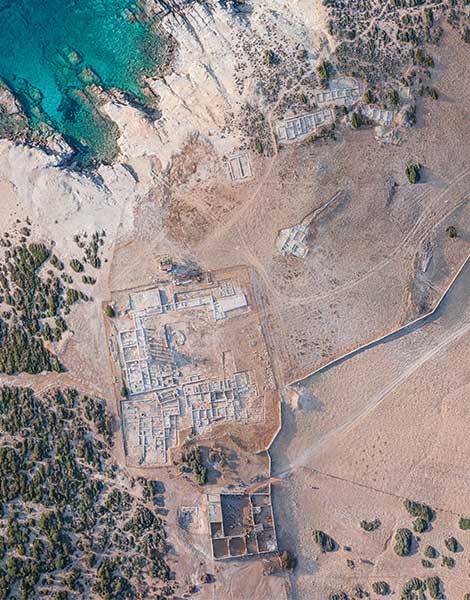This year, the archaeological excavations at the Sanctuary of Apollo on Despotiko, an uninhabited island in the Cyclades, were different in scale.
Every day, the fishing boat that took the team from Antiparos across to Despotiko, the “Island of the Kouroi”, or to the islet of Tsimidiri carried just five archaeology students, all from the University of Ioannina.
Unlike previous years, there were no students from foreign universities. The team did, however, also include three archaeologists: the head of excavations at Despotiko Yiannos Kouragios (Ephorate of Antiquities of the Cyclades), his close collaborator Ilia Daifa, and Alexandra Alexandridou, an assistant professor at the University of Ioannina.
During the four weeks that they worked, as Kouragios noted, “under bizarre conditions due to the pandemic and everything that resulted from it,” two new buildings were discovered on Despotiko, which brings the total number of structures found so far to 29. Another eight structures were found on Tsimidiri, an islet that was connected to Despotiko in ancient times via an isthmus, which brings the total there to ten, including those discovered last year.

© Ephorate of Antiquities of Cyclades

© Ephorate of Antiquities of Cyclades
The Restoration Works
The focus this year was placed on the restoration works of the Archaic temple and the sanctuary’s ceremonial hestiatorion (banquet hall). Specifically, the team focused on the north and west walls of the temple, which were restored using new and ancient materials, on the door-side wall of its rooms, on the entrances of the temple and the hestiatorion, as well as on the drums of the columns. As of the end of August, the restoration works had moved into their second and final phase.
Kouragios happily lists what has been accomplished, but notes that they still have to work on the eaves, stressing the effect that the newer white marble has on visitors. The Archaic temple, which rises six to seven meters above the ground, is already an imposing building, but “once the pediment has been reconstructed, it will be even more impressive.”
“Now we are going to focus on the facades of the hestiatorion and on the elements that will connect the cornices, so that the scaffolding can be removed from the monument. That scaffolding, which was donated by Athanasios Martinos, will be transferred to the archaeological site of Delos, where the Ephorate of Antiquities of the Cyclades has planned restoration works on the Stoa of Philippos, the Temple of Apollo, and more.”

© Ephorate of Antiquities of Cyclades

© Ephorate of Antiquities of Cyclades
What is important is that, after 22 years of excavations at Despotiko, the archaeological site is being prepared to accept visitors. There will be recommended routes, facilities for those with mobility issues, placards, and a guardhouse, while a wall currently under construction will prevent any potential damage from the goats of the neighboring property.
There is some discussion regarding ticket pricing, particularly in light of the fact that visitors to the site will also need to pay a seven-euro boat fare to reach Despotiko from Antiparos, but there’s also optimism.
“Next year,” Kouragios says, “I think we’ll be ready. Visitors will also be able to observe the restoration works that will be taking place in Building D, near the temple.”
The Archaeological Findings
Looking at this year’s findings in more detail indicates what awaits future visitors. On Despotiko, a building was discovered near the port, and this is the first structure those disembarking will encounter.
Another building west of the herdsman’s walls was also uncovered, a large structure featuring a variety of different architectural styles, whose foundations reach 3 meters below the ground. The fortified structure of the walls (they are over one meter thick) shows that this building was constructed during Archaic times, while the fact that the ceramics found in its interior date from a later period suggests that this structure was used over many years, well into late antiquity (the time of transition from classical antiquity to the Middle Ages).
“We believe that this structure was a large tank or cistern that was used to meet the needs of the sanctuary”, Kouragios says.

© Ephorate of Antiquities of Cyclades
On Tsimidiri, the ten buildings, all large, also feature strong construction elements. In one of the spaces, a large number of ceramic artifacts were found, as well as pieces of Archaic pithoi (large storage containers) featuring engravings and repoussé decoration from the 7th century B.C.
“These buildings, ” Kouragios says, “were warehouse facilities at the port’s entrance. The containers were intended for transporting oil. The port was where sailors would replenish their supplies of water, food and anything else they needed for their journey to Syria, Palestine, or any other destination.”
“Everything speaks to the exceptional organization by the polis of Paros, which founded the sanctuary and erected these strong surrounding structures. It was a protected harbor and a large temple with a ceremonial banquet hall, a precinct, priests, permanent staff and many visitors who would pay taxes and pay for their supplies. It was a very well-organized place of worship of the time.”
The sponsors who assisted with this project are the AEGEAS Non-Profit Civil Company, the Paul and Alexandra Canellopoulos Foundation, the A. G. Leventis Foundation, the municipality of Antiparos, the Friends of Paros Association, and the J. S. Latsis Foundation.












